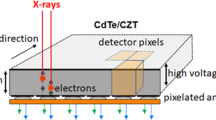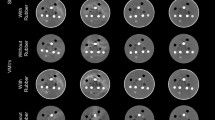Abstract
Purpose
To determine whether the left ventricular ejection fractions (EFs), measured on a high-sensitivity CZT single photon emission computed tomography (SPECT)-camera with a 70% reduction in recording times and a prevention of EF overestimation through an additional count-calibration, are concordant with reference EF from planar radionuclide angiography (2D-RNA).
Methods
An additional 10-minute CZT-SPECT recording was performed in patients referred to 2D-RNA for cardiomyopathy (n = 23) or chemotherapy monitoring (n = 50) with an in vivo red blood cell labeling with 850 MBq \( {}^{{99{\text{m}}}}{\text{TcO}}_{4}^{ - } \). The EF, obtained from CZT-SPECT with 100% (SPECT100) or 30% (SPECT30) projection times and with a SPECT-count calibration on the 2D-RNA counts of corresponding cavity volumes, were compared to EF from 2D-RNA.
Results
Strong and equivalent relationships were documented between the EF from 2D-RNA and the calibrated EF from SPECT100 (y = 0.89x + 6.62; R2 = 0.87) and SPECT30 (y = 0.87x + 8.40; R2 = 0.85), and the mean EF from SPECT100 (54% ± 15%) and SPECT30 (53% ± 16%) were close to that from 2D-RNA (55% ± 15%). However, upward shifts in these mean values were documented in the absence of count calibration for both SPECT100 (60% ± 18%) and SPECT30 (60% ± 18%).
Conclusion
Left ventricular EF may be determined on a high-sensitivity CZT-camera, a 70% reduction in injected activities, and an additional count-calibration for further enhancing the concordance with 2D-RNA values.
Spanish Abstract
Propósito
Determinar si la fracción de eyección del ventrículo izquierdo, medida con la cámara CZT-SPECT con una reducción del 70% en tiempo de grabación y con la prevención de la sobreestimación mediante una calibración de cuentas adicional, que sea concordante con el valor referencia de fracción de eyección mediante radiografía planar de radionucleidos. (2D-RNA).
Métodos
Una grabación adicional de 10 minutos con CZT-SPECT se realizo en pacientes referidos a radiografía planar de radionucleidos (2D-RNA) por miocardiopatías. (n = 23) o para monitorizar las quimioterapias (n = 50) con marcaje de glóbulos rojos con 850 MBq 99m TcO4. La fracción de eyección obtenida por CZT-SPECT con 100% (SPECT100) o 30% (SPECT30) de tiempo de proyección, y con SPECT con calibración de cuentas con el 2D-RNA, los volúmenes de cavidades fueron comparados con fracción de eyección . Relaciones fuertes y equivalentes fueron documentados entre fracción de eyección del 2D-RNA, y la forma calibrada de la fracción de eyección SPECT100 (y = 0.89x + 6.62; R2 = 0.87) y SPECT30 y = 0.87x + 8.40; R2 = 0.85), y la media de fracción de eyección de SPECT100 (54 ± 15%) and SPECT30 (53 ± 16%) fueron cercanos a la de el 2D-RNA (55 ± 15%). Aunque, aumentos en estas medias se documentaron en la ausencia de la calibración de cuentas para SPECT100 (60 ± 18%) y SPECT30 (60 ± 18%).
Conclusión
La fracción de eyección del ventrículo izquierdo puede ser determinada con una cámara CZT de alta sensibilidad, una reducción del 70% en actividades inyectadas y la calibración de cuentas adicional para realzar la concordancia con los valores de 2D-RNA.
Chinese Abstract
目的
以平面放射性核素血管造影 (2D-RNA) 测定左心室射血分数 (EF) 作为参考标准,为确定利用高灵敏度 CZT SPECT 相机在减少 70% 的记录时间, 并结合计数校准防止高估情况下测量的 EF值, 是否与 2D-RNA 测得的 EF 值一致。
方法
对心肌病 (n = 23) 或化疗监测 (n = 50) 的患者采用体内标记法注射 850 MBq 99mTcO4 标记的红细胞进行 2D-RNA ,随后再采集 10 分钟 CZT-SPECT。 对 CZT-SPECT 100% 投影时间 (SPECT100) 或 30% 投影时间 (SPECT30) 获得的图像进行重建, 并进行计数校准 (对相应容积获得的 2D-RNA 计数通过 SPECT 校准)获得 EF 值, 与 2D-RNA 测定的 EF 的进行比较。
结果
2D-RNA 测定的 EF 值与 SPECT100 校准后测定的 EF 值 (y = 0.89x + 6.62; R2 = 0.87) 及 SPECT30 (y = 0.87x + 8.40; R2 = 0.85) 校准后 EF 值具有高度相关性, 并且 SPECT100 (54 ± 15%) 和 SPECT30 (53 ± 16%) 测定的 EF 平均值与 2D-RNA 测定的 EF 平均值 (55 ± 15%) 非常接近。 但是, 在没有计数校准的情况下, SPECT100 (60 ± 18%) 和 SPECT30 (60 ± 18%) 测定的 EF 平均值会被高估。
结论
高灵敏度 CZT 相机可在减少 70% 的注射剂量情况下测定左心室 EF 值, 结合计数校准可进一步提高与 2D-RNA测得的 EF 值的一致性。
关键词: 放射性核素血管造影; 血池 SPECT; CZT 相机; 左心室射血分数; 校准曲线。
French Abstract
Objectif
Déterminer si les fractions d'éjection ventriculaire gauche (EF) mesurées sur une caméra CZT SPECT à haute sensibilité avec une réduction de 70% des temps d'enregistrement et une prévention de la surestimation de l'EF grâce à un étalonnage supplémentaire des coups concordent avec les EF de référence obtenues par angiographie scintigraphique planaire (2D-RNA).
Méthodes
Un enregistrement CZT-SPECT supplémentaire de 10 minutes a été réalisé chez les patients référés pour évaluation de cardiomyopathie (n=23) ou suivi de chimiothérapie (n = 50) par angiographie scintigraphique planaire (2D-RNA) au globules rouges marqués avec 850 MBq 99mTcO4-. Les EF, obtenues au moyen d’une caméra CZT-SPECT avec 100% (SPECT100) ou 30% (SPECT30) de temps d’acquisition et avec étalonnage des coups SPECT sur les images 2D-RNA des volumes de cavité correspondants ont été comparés aux EF à partir de 2D-RNA.
Résultats
une corrélation significative existe entre les EF obtenues par 2D-RNA et les EF étalonnées obtenues par SPECT100 (y = 0,89x + 6,62; R2 = 0,87) et SPECT30 (y = 0,87x + 8,40; R2 = 0,85). Les EF moyennes de SPECT100 (54 ± 15%) et SPECT30 (53 ± 16%) sont similaires à celles obtenues par 2D-RNA (55 ± 15%). En l'absence d'étalonnage de comptage des études SPECT100 (60 ± 18%) et SPECT30 (60 ± 18%), ces valeurs moyennes d’EF sont généralement plus élevées.
Conclusion
La fonction ventriculaire gauche peut être déterminée avec une caméra CZT à haute sensibilité, une réduction des activités injectées et un étalonnage supplémentaire des coups pour améliorer la concordance avec les valeurs obtenues par 2D-RNA.




Similar content being viewed by others
Abbreviations
- 2D-RNA:
-
Planar radionuclide angiography
- EDC:
-
End-diastolic counts
- EDV:
-
End-diastolic volume
- EF:
-
Ejection fraction
- ESC:
-
End-systolic counts
- ESV:
-
End-systolic volume
- LV:
-
Left ventricle
- SPECT:
-
Single photon emission computed tomography
- SPECT30:
-
SPECT images reconstructed with only 30% of recorded counts
- SPECT100:
-
SPECT images reconstructed with 100% of recorded counts
References
Alvarez JA, Russell RR. Cardio-oncology: The nuclear option. Curr Cardiol Rep. 2017;19:31.
Curigliano G, Cardinale T, Suter T, et al. Cardiovascular toxicity induced by chemotherapy, targeted agents and radiotherapy: ESMO clinical practice guidelines. Ann Oncol. 2012;23:vii155–66.
Duvall WL, Guma-Demers KA, George T, Henzlova MJ. Radiation reduction and faster acquisition times with SPECT gated blood pool scans using a high-efficiency cardiac SPECT camera. J Nucl Cardiol. 2016;23:1128–38.
Hesse B, Lindhardt TB, Acampa W, et al. EANM/ESC guidelines for radionuclide imaging of cardiac function. Eur J Nucl Med Mol Imaging. 2008;35:851–85.
Chen YC, Ko CL, Yen RF, et al. Comparison of biventricular ejection fractions using cadmium–zinc–telluride SPECT and planar equilibrium radionuclide angiography. J Nucl Cardiol. 2016;23:348–61.
Rydberg J, Andersen J, Haarmark C, Zerahn B. The influence of anthropometric and basic circulatory variables on count rate in cadmium–zinc–telluride SPECT gated radionuclide angiography. J Nucl Cardiol. 2018. https://doi.org/10.1007/s12350-018-1402-9.
Imbert L, Poussier S, Franken PR, et al. Compared performance of high-sensitivity cameras dedicated to myocardial perfusion SPECT: A comprehensive analysis of phantom and human images. J Nucl Med. 2012;53:1897–903.
Perrin M, Djaballah W, Moulin F, et al. Stress-first protocol for myocardial perfusion SPECT imaging with semiconductor cameras: High diagnostic performances with significant reduction in patient radiation doses. Eur J Nucl Med Mol Imaging. 2015;42:1004–11.
Verger A, Imbert L, Yagdigul Y, et al. Factors affecting the myocardial activity acquired during exercise SPECT with a high-sensitivity cardiac CZT camera as compared with conventional Anger camera. Eur J Nucl Med Mol Imaging. 2014;41:522–8.
Claudin M, Imbert L, Djaballah W, et al. Routine evaluation of left ventricular function using CZT-SPECT, with low injected activities and limited recording times. J Nucl Cardiol. 2018;25:249–56.
Imbert L, Roch V, Merlin C, et al. Low-dose dual-isotope procedure planed for myocardial perfusion CZT-SPECT and assessed through a head-to-head comparison with a conventional single-isotope protocol. J Nucl Cardiol. 2018. https://doi.org/10.1007/s12350-017-0914-z.
Tonge CM, Fernandez RC, Harbinson MT. Commentary: current issues in nuclear cardiology [commentary]. Br J Radiol. 2008;81:270–4.
Bartlett ML, Srinivassan G, Baker WC, Kitsiou AN, Dilsizian V, Bacharach SL. Left ventricular ejection fraction: Comparison of results from planar and SPECT gated blood pool studies. J Nucl Med. 1996;37:1795–9.
Jensen MM, Schmidt U, Huang C, Zerahn B. Gated tomographic radionuclide angiography using cadmium–zinc–telluride detector gamma camera; comparison to traditional gamma cameras. J Nucl Cardiol. 2014;21:384–96.
Jensen MM, Haase C, Zerahn B. Interstudy repeatability of left and right ventricular volume estimations by serial-gated tomographic radionuclide angiographies using a cadmium–zinc telluride detector gamma camera. Clin Physiol Funct Imaging. 2015;35:418–24.
Djaballah W, Muller MA, Bertrand AC, et al. Gated SPECT assessment of left ventricular function is sensitive to small patient motions and to low rates of triggering errors: A comparison with equilibrium radionuclide angiography. J Nucl Cardiol. 2005;12:78–85.
Nakajima K, Okuda K, Nyström K, et al. Improved quantification of small hearts for gated myocardial perfusion imaging. Eur J Nucl Med Mol Imaging. 2013;40:1163–70.
Bailliez A, Lairez O, Merlin C, et al. Left ventricular function assessment using 2 different cadmium–zinc–telluride cameras compared with a γ-camera with cardiofocal collimators: Dynamic cardiac phantom study and clinical validation. J Nucl Med. 2016;57:1370–5.
Slart RH, Tio RA, Zeebregts CJ, Willemsen AT, Dierckx RA, De Sutter J. Attenuation corrected gated SPECT for the assessment of left ventricular ejection fraction and volumes. Ann Nucl Med. 2008;22:171–6.
Sibille L, Bouallegue FB, Bourdon A, Mariano-Goulart D. Influence of CT-based attenuation correction in assessment of left and right ventricular functions with count-based gated blood-pool SPECT. J Nucl Cardiol. 2011;18:642–9.
De Bondt P, De Winter O, De Sutter J, Dierckx RA. Agreement between four available algorithms to evaluate global systolic left and right ventricular function from tomographic radionuclide ventriculography and comparison with planar imaging. Nucl Med Commun. 2005;26:351–9.
Harel F, Finnerty V, Ngo Q, Gregoire J, Khairy P, Thibault B. SPECT versus planar gated blood pool imaging for left ventricular evaluation. J Nucl Cardiol. 2007;14:544–9.
Cousins C, Miller DL, Bernardi G, et al. ICRP publication 120: Radiological protection in cardiology. Ann ICRP. 2013;42:1–125.
Van Kriekinge SD, Berman DS, Germano G. Automatic quantification of left ventricular ejection fraction from gated blood pool SPECT. J Nucl Cardiol. 1999;6:498–506.
Harel F, Finnerty V, Grégoire J, et al. Gated blood-pool SPECT versus cardiac magnetic resonance imaging for the assessment of left ventricular volumes and ejection fraction. J Nucl Cardiol. 2010;17:427–34.
Xie BQ, Tian YQ, Zhang J, et al. Evaluation of left and right ventricular ejection fraction and volumes from gated blood-pool SPECT in patients with dilated cardiomyopathy: Comparison with cardiac MRI. J Nucl Med. 2012;53:584–91.
Acknowledgments
The authors thank Nathaniel Roth and Rafael Baavour from Spectrum Dynamics Medical for their technical support and Pierre Pothier for critical review of the manuscript.
Author information
Authors and Affiliations
Corresponding author
Ethics declarations
Disclosure
The authors declare that they have no conflict of interest.
Additional information
Publisher's Note
Springer Nature remains neutral with regard to jurisdictional claims in published maps and institutional affiliations.
JNC thanks Erick Alexanderson MD, Carlos Guitar MD, and Diego Vences MD, UNAM, Mexico, for providing the Spanish abstract; Haipeng Tang MS, Zhixin Jiang MD, and Weihua Zhou PhD, for providing the Chinese abstract; and Jean-Luc Urbain, MD, PhD, CPE, Past President CANM, Chief Nuclear Medicine, Lebanon VAMC, PA, for providing the French abstract.
Electronic supplementary material
Below is the link to the electronic supplementary material.
Rights and permissions
About this article
Cite this article
Tissot, H., Roch, V., Morel, O. et al. Left ventricular ejection fraction determined with the simulation of a very low-dose CZT-SPECT protocol and an additional count-calibration on planar radionuclide angiographic data. J. Nucl. Cardiol. 26, 1539–1549 (2019). https://doi.org/10.1007/s12350-019-01619-w
Received:
Accepted:
Published:
Issue Date:
DOI: https://doi.org/10.1007/s12350-019-01619-w




